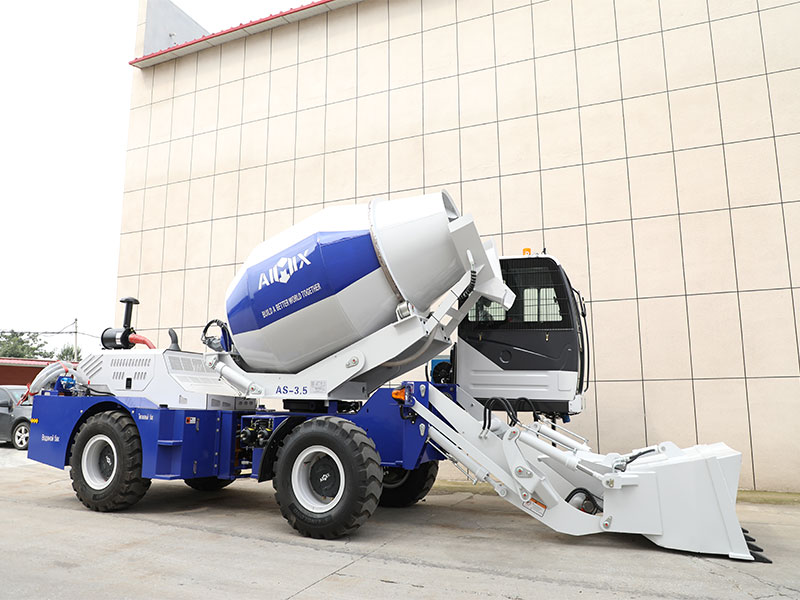In the realm of construction, the quality of concrete is paramount to the structural integrity and longevity of buildings and infrastructure projects. With the advent of self-loading concrete mixers, there's a growing interest in understanding the quality of concrete they produce. These innovative machines promise efficiency, convenience, and versatility in concrete production, but how does the quality of their output measure up? Let's delve into this topic and explore the factors that influence the quality of concrete from self-loading mixers.
Understanding Self-Loading Concrete Mixers:
Self-loading concrete mixers combine the functions of a concrete mixer and a front-end loader, enabling operators to batch, mix, transport, and discharge concrete on-site with minimal manual intervention. These self-loading mobile mixers boast features such as four-wheel drive, articulated steering, and a rotating drum, allowing for efficient operation in diverse construction environments. While they offer undeniable advantages in terms of mobility and productivity, questions often arise regarding the quality of concrete they produce.

Factors Influencing Concrete Quality:
Several factors contribute to the quality of concrete produced by self-loading mixers:
Mix Design: The composition of the concrete mix plays a crucial role in determining its strength, durability, and workability. Proper mix design, including the correct proportions of cement, aggregates, water, and additives, is essential for achieving the desired concrete properties. Self-loading mixers must adhere to specified mix designs to ensure consistent quality in the produced concrete.
Mixing Efficiency: The mixing process directly impacts the homogeneity and uniformity of the concrete mix. Small self loader concrete mixers employ rotating drums to blend the ingredients thoroughly. However, the effectiveness of mixing may vary depending on factors such as drum speed, duration of mixing, and loading sequence. Proper mixing techniques are vital to prevent segregation and ensure uniform distribution of materials throughout the mix.
Material Quality: The quality of raw materials, including cement, aggregates, and water, significantly influences the performance of the concrete. Self-loading mixers rely on locally sourced materials, and the quality of these inputs can vary. Ensuring that materials meet relevant standards and specifications is essential for producing high-quality concrete.
Water-Cement Ratio: The water-cement ratio is a critical parameter that affects the strength and durability of concrete. Maintaining an appropriate water-cement ratio is crucial to achieving optimal concrete performance. Self-loading mixers should accurately control the water-cement ratio during the batching process to prevent issues such as shrinkage, cracking, and reduced strength.

Curing Conditions: Proper curing is essential to allow concrete to attain its full strength and durability. Self-loading mixers should facilitate adequate curing by providing suitable conditions such as moisture retention and temperature control. Failure to implement proper curing practices can compromise the quality of the concrete and lead to structural deficiencies.
Assessing Concrete Quality:
To evaluate the quality of concrete produced by self-loading mixers, various tests and assessments can be conducted:
Compressive Strength Test: This test determines the maximum compressive load a concrete specimen can bear before failure. Samples are prepared and cured according to standard procedures, and compressive strength is measured using specialized equipment. High compressive strength indicates good quality concrete with adequate structural performance.
Slump Test: The slump test assesses the consistency and workability of fresh concrete. A slump cone is filled with concrete, and the cone is removed to observe the deformation of the concrete mass. The degree of slump indicates the ease of placement and compaction of the concrete mix.
Durability Tests: Various durability tests, such as water absorption, chloride ion penetration, and freeze-thaw resistance, evaluate the ability of concrete to withstand environmental factors and degradation over time. These tests provide valuable insights into the long-term performance of the concrete.
Visual Inspection: Visual inspection of the concrete surface can reveal signs of segregation, honeycombing, cracks, or other defects that may indicate poor quality or improper construction practices.
Conclusion:
Self-loading concrete mixers offer a convenient and efficient solution for on-site concrete production, but their performance ultimately hinges on the quality of the concrete they produce. By considering factors such as mix design, mixing efficiency, material quality, water-cement ratio, and curing conditions, operators can ensure that the aimix self loading concrete mixer yields high-quality concrete suitable for various construction applications. Through rigorous testing and quality control measures, the industry can uphold standards of excellence and integrity in concrete production, fostering safer, more resilient, and sustainable built environments.





